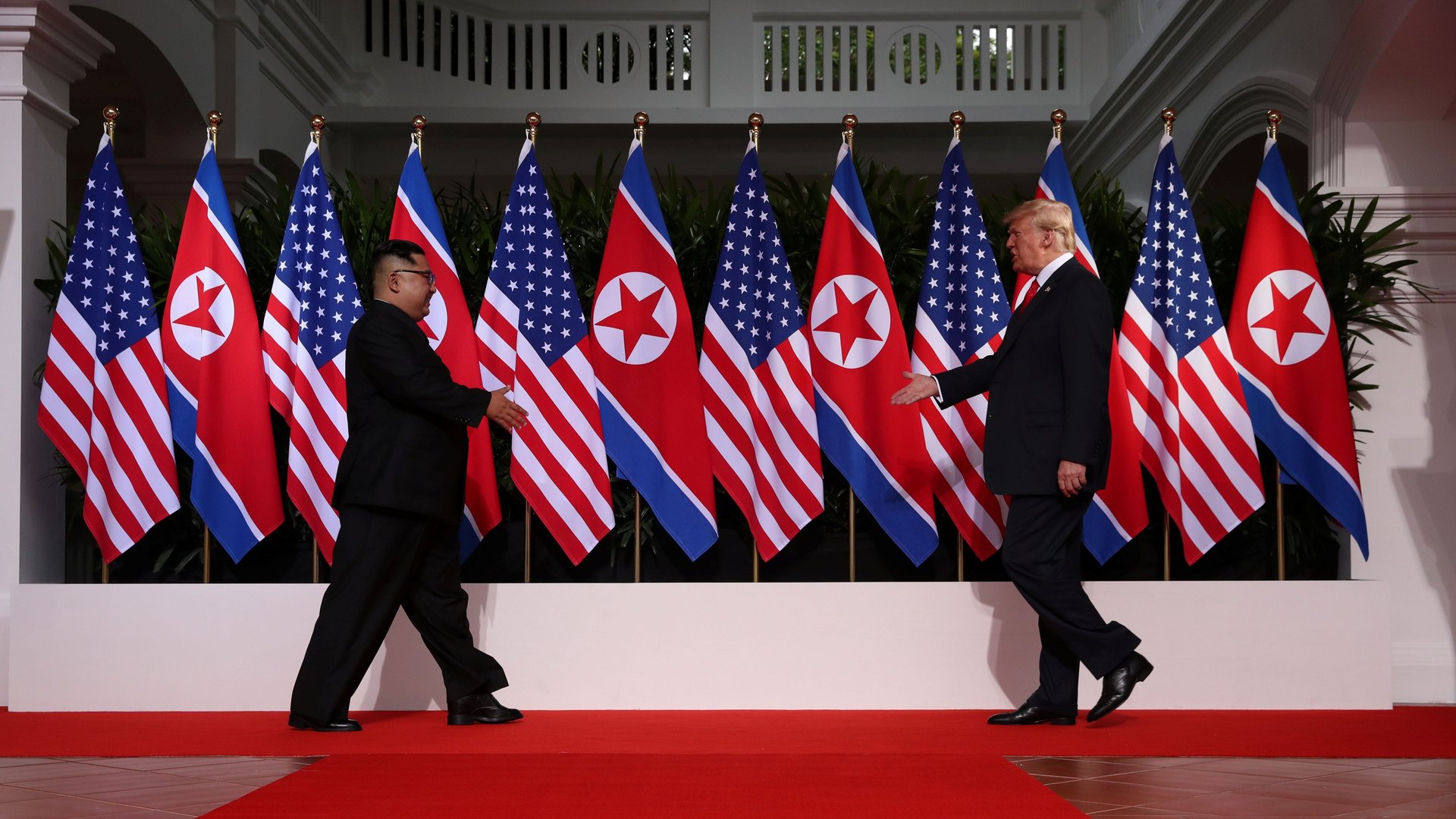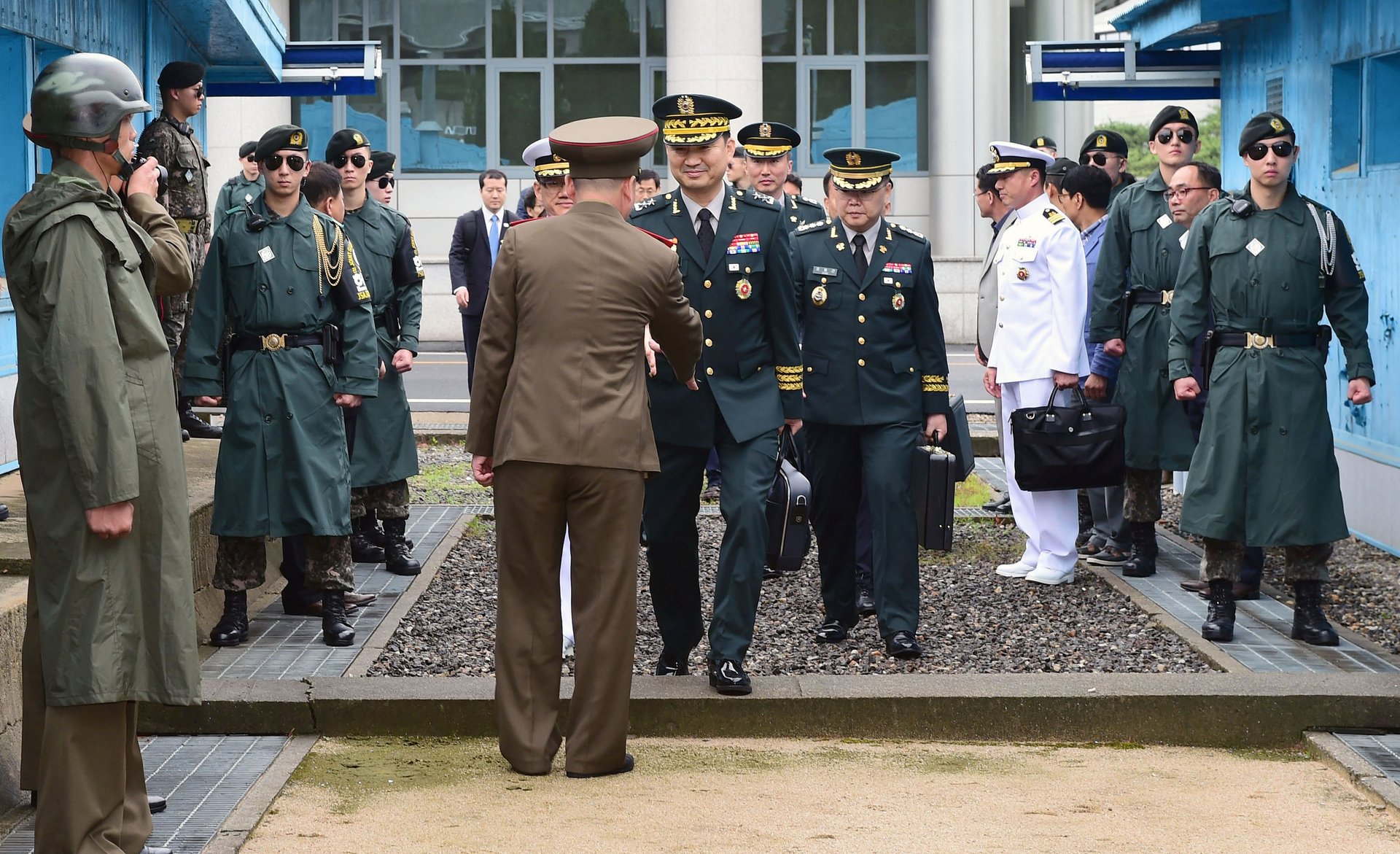The real winners from the Trump-Kim summit will be North Korea’s neighbors
The historic Trump-Kim summit in Singapore was a mix of deja vu and historic milestone. Never had a sitting US president met the leader of North Korea face-to-face, but their meeting resulted in a declaration that at most vaguely restated agreements made by his late father Kim Jong Il—and we all know how honestly North Korea abided by those. Still, the millennial Kim Jong Un is a different man and clearly doesn’t want to spend the next half-century leading the world’s most destitute and despotic state. He has taken a calculated first step and gained the reputational coup his father failed to by meeting the US president eye-to-eye. Now he is opening North Korea to geopolitical forces beyond his immediate control.


The historic Trump-Kim summit in Singapore was a mix of deja vu and historic milestone. Never had a sitting US president met the leader of North Korea face-to-face, but their meeting resulted in a declaration that at most vaguely restated agreements made by his late father Kim Jong Il—and we all know how honestly North Korea abided by those. Still, the millennial Kim Jong Un is a different man and clearly doesn’t want to spend the next half-century leading the world’s most destitute and despotic state. He has taken a calculated first step and gained the reputational coup his father failed to by meeting the US president eye-to-eye. Now he is opening North Korea to geopolitical forces beyond his immediate control.
The Trump-Kim summit in Singapore produced a bold (if brief) statement that kicks off a web of processes calling for irreversible denuclearization, a formal end to the Korean War, and possible reunification. How these three processes play out—amidst a new round of jockeying for regional influence amongst powers such as China and Japan—will determine the future geopolitical order of Northeast Asia.
Each party has a preference for the sequencing of these processes, and there are some signs of concessions. North Korea, for example, is mothballing certain nuclear facilities, while President Trump stated during his Singapore press conference that the US will end the bilateral “war games” conducted with South Korea (much to the latter’s dismay). For all sides to get what they want, North and South Korea, and China and the US, will have to move incrementally, simultaneously, and in good faith on all fronts.
As North Korea is unlocked into a passageway between Russia and China to the north and South Korea, how will the new arms race of connectivity unfold in Northeast Asia?
Given the continued lack of clarity about whether the US and North Korea agree on the precise definition of denuclearization, it is safe to say that North Korea will not give up its stockpile of an estimated 60 nuclear warheads “very quickly,” as Trump claimed. Indeed, Secretary of State Mike Pompeo has said it could take two to three years at best. The next major headline related to North Korea is therefore likely to come from progress in North-South Korean relations. A peace agreement to formally end the Korean War will replace the old patterns of geopolitics—territorial division and guarded sovereignty—with new dynamics already prevailing worldwide: Competing to connect across borders to control markets. Over the past two decades, China has raced ahead to build pipelines, highways, railways and other infrastructures across the former Soviet republics of Central Asia. There, through its monumental Belt & Road Initiative, China has taken a lead in what is widely referred to as the “new Great Game” (a reprise of 19th century Anglo-Soviet maneuvering in the same Turkic-Afghan-Tibetan region) by building the new Silk Roads.
North Korea has long been dependent on China for its survival, but the only way to come out of China’s shadow is to pursue eventual reunification with South Korea. Kim Jong Un and those North Koreans with knowledge of China and South Korea’s spectacular levels of modernization are aware of the generational economic opportunity before them. Inviting North Korean officials to not only observe but participate in the South’s modern capitalist democracy may give them the inspirational exposure and incentive they need to pursue a similar course. Germany provides a useful precedent here. Unlike numerous post-Communist eastern European states, Germany was wise not to purge former East German officials for their complicity with the communist regime. For a perhaps indefinite period, only North Koreans will truly know how to govern their portion of the country on the ground level.
The integration of North and South will thus occur much more quickly through supply chains than politics. The cost of modernizing North Korea’s decrepit infrastructure and caring for its 25 million mostly impoverished citizens is estimated to cost several trillion dollars over multiple decades, similar to what has been spent by West German taxpayers on East Germany through the country’s solidarity tax. Importantly, however, North Korea has the potential to become a productive engine of the new Korea almost as soon as sanctions are lifted. Indeed, whereas the early 1990s EU expansion lured German industry to Poland, North Korea’s vast resources and low wages will make it a go-to destination. Samsung, Hyundai, Daewoo and other major South Korean corporates have already employed low-cost North Korean labor in special economic zones along the border such as the Kaesong Industrial Park. These same corporates are expected to score many years worth of mega-engineering projects to rebuild North Korea.
Importantly, this is not first time Kim Jong Un is awakening to the need for a national overhaul. Several years ago, while cross-border special economic zones were still operating before tightened sanctions choked them off, he instructed a dozen provinces to develop plans for similar industrial parks spanning agribusiness and tourism. Furthermore, North Korea holds an estimated $6 trillion worth of mineral reserves of iron, gold, copper, magnesium, graphite and other deposits. North Korea, then, could follow the model of Vietnam (and China) with the government retaining the political control it demands, but expanding the basis of its legitimacy to include genuinely broad-based economic growth and improvement in citizens’ quality of life.
Investors are also surprisingly keen on the North Korean story. The world is awash in liquidity held by sovereign wealth funds, billionaires, private equity firms and frontier market speculators keen to own a piece of the country sandwiched between far more productive neighbors keen to uplift it. As in Myanmar, business is likely to flood in from all directions. Markets and mobile phones could reach nearly 100% of the population in a few quick years. While North Korea today could only charitably be compared to a nuclear-armed Turkmenistan, it could in short order emulate post-Communist Romania, becoming an important new regional breadbasket.
China and Russia, whose lifelines have kept North Korea afloat all these years, could continue to play significant strategic roles, especially in major industries. China has pledged to resume direct Air China flights to Pyongyang, and already has railways planned to the port of Rason (Rajin) on the Sea of Japan, giving it access to the Sea of Japan rather than only the Yellow Sea. Russia wants to extend its fabled trans-Siberian railway from Vladivostok through Pyongyang to Seoul.
It is premature, however, to assume China’s sheer size will naturally allow it to dominate the new Korea’s fragile north, pulling it into its exclusive sphere of influence. The growing rift (paywall) between the erstwhile communist allies is not only one of the deeper causes of North Korea’s opening, but the North’s heightened suspicions of China mean both its military and elites will be on guard against excessive Chinese infiltration—very much the phenomenon playing out in Central Asian states such as Kazakhstan and Pakistan.

In the medium-term, it is more likely that a unified Korea would graduate from its historical role as a minor kingdom “in between” China and Japan to a more confident and industrious economic power of nearly 80 million people. Japan, which has already been losing its technological edge to both South Korea and China, will need to bury the World War II hatchet with its historical rivals as well. Despite his nationalist flair, president Shinzo Abe may feel compelled to more formally apologize for imperial Japan’s rapacious conquests for fear of having his country excluded from, and eclipsed by the Sino-Korean growth corridor. This is why, for example, South Korea has been lobbying Japan to join the Asian Infrastructure Investment Bank (AIIB), while Japan has been nudging South Korea to join the Trans-Pacific Partnership (TPP) trade agreement.
Such steps at strategic reconciliation would be consistent both with the region’s historical patterns and recent trends. There are millennia of precedent for three-way stability between China, Korea and Japan, characterized by dynasties sharing Confucian culture, Buddhist spirituality and technological innovation. The conveyor belt among them generates $4.2 trillion in exports annually, more than the EU and North America combined.
Furthermore, the younger generation across Northeast Asia is much less shaped by negative historical memories. Record numbers of Chinese, Japanese and Korean students study in each other’s countries, learn each other’s languages, work across their borders and inter-marry with each other. They read Japanese literature, watch Chinese movies, and listen to K-Pop music. Even with ongoing disputes over the Senkaku/Diaoyou Islands, China’s Aerial Defense Identification Zone (ADIZ) and other tensions, Asia’s youth has no inhibitions about embracing neighbors.
This sentiment will surely be extended to the people of North Korea. During my visit there several years ago, I was struck by the admirable preservation of Confucian heritage, something many South Koreans feel has been neglected in favor of material pursuits. I also met a range of ordinary parents who told me bluntly they would prefer their children learn English than be recruited into the year-long training for the country’s stadium filling mass games. Kim himself probably dreams of hosting NBA teams and European soccer clubs.
Should the country open, North Koreans will, like Iranians and Cubans, gain viewpoints that challenge the story they have been fed for decades and come to doubt through their own common sense. To temper their inevitable humiliation, Kim Jong Un—should he indeed be able to carry out the juggling act of pursuing peace abroad and forestalling saboteurs at home—should be given long rhetorical leash to portray reconciliation as a victory for the cause of forcing America off the peninsula, even as the US military presence continues to be negotiated. Foreign visitors should appreciate the country’s cultural offerings so that North Koreans can see themselves as a rich civilization that was temporarily trapped in an anachronistic state.
American policy will continue to have a major influence on the outcome of this historic process. The US has spent decades bringing post-war Japan and South Korea closer together, and must continue to reassure both that it will protect them in the event of any escalations with China, or derailment of Korean reunification. If all goes well, it will no longer do so from the Korean peninsula itself.
This article is part of Quartz Ideas, our home for bold arguments and big thinkers.